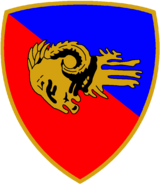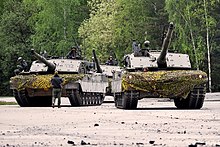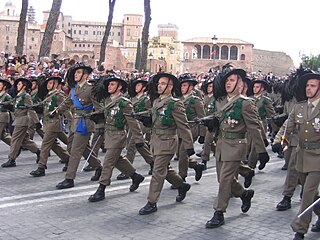
The Bersaglieri, singular Bersagliere, are a troop of marksmen in the Italian Army's infantry corps. They were originally created by General Alessandro Ferrero La Marmora on 18 June 1836 to serve in the Royal Sardinian Army, which later became the Royal Italian Army. They can be recognized by their distinctive wide-brimmed hats decorated with black western capercaillie feathers, which is worn with the dress uniform. The feathers are also applied to their combat helmets.
On March 1, 1984 the Italian Institute for Disarmament, Development and Peace (Istituto di ricerche per il disarmo, lo sviluppo e la pace in Rome published the entire Italian Army order of battle down to company level – this was justified by the radical party as one of its core demands was total disarmament of Europe, even though the data which was published was top secret. The Radical Party dissolved in 1989 and the IRDISP followed suit in 1990. But Radio Radicale has survived, and the OrBat can still be found today on the homepage of the radio.

The Cavalry Brigade "Pozzuolo del Friuli" is a brigade of the Italian Army, based in the Friuli-Venezia Giulia and Veneto regions. The Brigade consists of a command unit, a cavalry regiment, an amphibious infantry regiment, an artillery regiment, an engineer regiment and a logistic regiment.
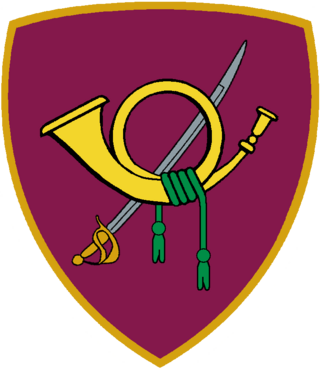
The Bersaglieri Brigade "Garibaldi" is a mechanized infantry brigade of the Italian Army, based in the south of the country. Its core units are Bersaglieri, an elite infantry corps of the Italian Army. The brigade is named after Giuseppe Garibaldi, a hero of the Italian wars of unification. The brigade is part of the Division "Acqui".
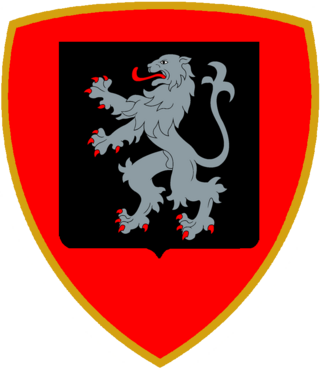
The Mechanized Brigade "Aosta" is a mechanized infantry brigade of the Italian Army based on the island of Sicily. The Brigade is one of the oldest of the Italian Army and the name connects the brigade to its original area of recruitment the Aosta Valley and therefore the brigade's coat of arms is modeled after the coat of arms of Aosta. The brigade is part of the Division "Acqui".

The 131st Armored Division "Centauro" was an armored division of the Italian Army during World War II. The division was formed in April 1939 by expanding the I Armored Brigade. The division's name came from the mythological race of half human-half horse creatures named Centaurs. The division participated in the invasion of Albania, Greco-Italian War, and invasion of Yugoslavia. In August 1942 the division was sent to Libya to participate in the Western Desert Campaign. After the Axis defeat at the Second Battle of El Alamein the division retreated with the German-Italian Panzer Army to Tunisia, where the division participated in the Tunisian Campaign. On 18 April 1943 the division was disbanded due to the losses suffered in the Battle of El Guettar.

After World War II the Italian Army had two units named "Centauro": from 1952 to 1986 the Armored Division "Centauro" and from 1986 to 2002 the Armored Brigade "Centauro". Both units were successor to the World War II era 131st Armored Division "Centauro". The units' name came from the mythological race of half human-half horse creatures named Centaurs.

The 32nd Armored Brigade "Mameli" was an armored brigade of the Italian Army. Its core units were tank and Bersaglieri battalions. The brigade was headquartered in the city of Tauriano, a subdivision of the city of Spilimbergo. All the brigade's units were based in Spilimbergo. The brigade's name was chosen to honor the Italian patriot Goffredo Mameli writer of the lyrics of the Italian national anthem. The brigade's sister brigades, the 132nd Armored Brigade "Manin" and 8th Mechanized Brigade "Garibaldi" were named to honor of Daniele Manin and Giuseppe Garibaldi, both heroes of the Italian unification.
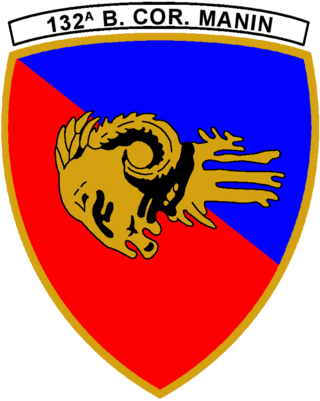
The 132nd Armored Brigade "Manin" was a short-lived armored brigade of the Italian Army based in the country's North-East. Its core units were tank and Bersaglieri battalions from the disbanded 132nd Tank Regiment of the 132nd Armored Division "Ariete". The brigade's headquarters was in the city of Aviano and the brigade's name honored the Italian unification hero Daniele Manin.

The 3rd Missiles Brigade "Aquileia" was an artillery brigade of the Italian Army active between 1959 and 1991. The brigade was stationed in North-Eastern Italy and armed with missile and artillery systems capable of firing tactical nuclear weapons as part of Italy's participation in NATOs nuclear sharing programme. During peacetime the brigade fell under command of the Italian V Army Corps, but during wartime the brigade would have been subordinate to NATOs Allied Land Forces Southern Europe (LANDSOUTH) command in Verona. After the end of the Cold War the brigade was disbanded and its weapon systems retired.

The Mechanized Brigade "Mantova" was a mechanized brigade of the Italian Army. Its core units were mechanized infantry battalions. The brigade's headquarters was in the city of Cividale del Friuli and all the brigade's units were based in the region of Friuli-Venezia Giulia. In 2003, the "Mantova" was raised again as a division command.

The Mechanized Brigade "Legnano" was a mechanized brigade of the Italian Army. Its core units were mechanized infantry battalions. The brigade's headquarters was in the city of Bergamo in Lombardy. The name of the brigade commemorates the Lombard League victory in the Battle of Legnano in 1176 and its coat of arms depicts the Monument to the Warrior of Legnano in the centre of Legnano.

The Mechanized Division "Folgore" was a mechanized division of the Italian Army. Its core units were three mechanized brigades. The brigades headquarters was in the city of Treviso.
The following is a hierarchical outline for the Italian Army at the end of the Cold War. It is intended to convey the connections and relationships between units and formations.
With the 1975 reforms the Italian Army abolished the regimental level and replaced it with brigades made up of multiple arms. During the reform the army disbanded 48 regimental commands and reduced its force by 87 battalions. A further ten regimental commands were used to raise ten new brigade commands. Ten training centers, which for traditional reasons had carried the names of regiments, were also disbanded. The reduction in units also allowed to mechanize most of the remaining units in Northern Italy and Italy's defense strategy changed from a hold-at-all-costs territorial defense to one of mobile warfare.

The 132nd Tank Regiment is a tank regiment of the Italian Army based in Cordenons in Friuli-Venezia Giulia. Originally the regiment, like all Italian tank units, was part of the infantry, but since 1 June 1999 it is part of the cavalry. Operationally the regiment is assigned to the 132nd Armored Brigade "Ariete".

The 132nd Field Artillery Regiment "Ariete" is a field artillery regiment of the Italian Army, specializing in armored combat. Originally an armored artillery regiment of the Royal Italian Army, the regiment was assigned during World War II to the 132nd Armored Division "Ariete", with which it fought in the Western Desert campaign until the division and regiment were destroyed in the Second Battle of El Alamein.
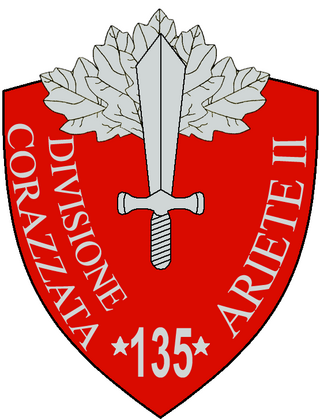
The 135th Armored Cavalry Division "Ariete" was an armored division of the Royal Italian Army during World War II. It was formed in 1943 and named to commemorate the 132nd Armored Division "Ariete", which had distinguished itself during the Western Desert campaign and was destroyed during the Second Battle of El Alamein. After the announcement of the Armistice of Cassibile on 8 September 1943 the division fought the invading German forces South of Rome. After two days the division was forced to surrender and was disbanded by the Germans on 12 September 1943.

The 50th Maneuver Logistic Battalion "Carnia" is an inactive logistics unit of the Italian Army. The battalion was formed in 1975 as Logistic Battalion "Ariete" and assigned to the Armored Division "Ariete". After the division was disbanded in 1986 the battalion was reorganized as a corps logistic battalion, renamed 50th Maneuver Logistic Battalion "Carnia" and assigned to the 5th Army Corps. The battalion was disbanded in 1991. The regimental anniversary falls, as for all units of the Transport and Materiel Corps, on 22 May, the anniversary of the Italian Army's first major automobile use to transport reinforcements to counter the Austro-Hungarian Offensive at Asiago in 1916.
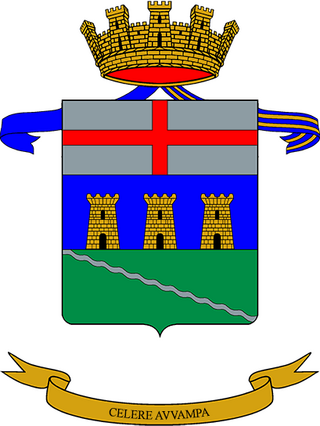
The 20th Artillery Regiment "Piave" is an inactive field artillery regiment of the Italian Army, which was based in Maniago in Friuli-Venezia Giulia. Originally an artillery regiment of the Royal Italian Army, the regiment was formed in 1888 and served in World War I on the Italian front. In 1935 the regiment was assigned to the 10th Infantry Division "Piave", with which the regiment served in World War II. After the Armistice of Cassibile was announced on 8 September 1943, the division and its regiments were disbanded on 10 September by invading German forces.
